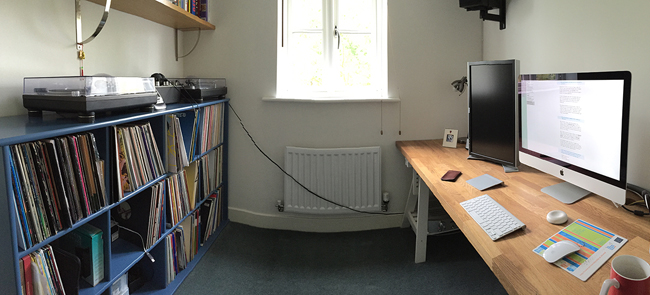- Published on
Hi. I’m Aaron Russell. I’m a UK-based software developer and designer, and I run a boutique web development company called Push Code.
We work with small companies and startups helping them develop and launch their online product or service. I’ll get involved in as much of that process as is needed, from design to front- and back-end development.
Over the past year I’ve also been working on a new open source content management system called PushType for Ruby on Rails. This is a new venture for me and something I’m getting increasingly excited about.
How did you get started in web design & development at Push Code, what is your background?
I started Push Code in 2012 and prior to that I’d already been self employed as a freelance web designer/developer for 4 years. Before that I’d spent a couple of years working in the industry, both in-house for a small startup and within a digital agency.
I actually came in to the industry as a designer - I wanted to design websites, so that’s what I trained as. However, I’ve always been quite strong technically and over time I’ve inevitably ended up getting involved in the more technical aspects of the job, learning more as I go. These days people come to me primarily as a Ruby or JavaScript developer, and truthfully that’s what I’m best at. I still get to dip my toe in to design work from time to time, but less frequently than I used to.
Where did you study? Looking back, would you recommend your path to beginners?
My route in to the industry was an unconventional one. I taught myself how to create web pages when I was about 16. I knew the web was going to be an important part of my life but back then (the mid-90s) the web was only beginning to establish itself. There weren’t any clearly defined routes in to the industry - in fact, there wasn’t really a web design industry.
So my interest in the web remained a geeky bedroom hobby and for quite a few years I didn’t really have a path or career to speak of. I worked from the age of 16 and had lots of different jobs but put most of my energy into trying to be an international superstar DJ.(Being a DJ didn’t quite work out, but I do now have an awesome record collection - all within reach of my desk).

I somehow ended up working in marketing and was enjoying working with graphic designers producing printed brochures and reports. I realised I quite fancied being a designer, so picked an interactive design course at my local college and went back to college for two years as a mature student whilst I continued working.
On a technical level the course didn’t teach me much about the web I didn’t already know, but creatively the course was useful. It taught me a great deal about thinking creatively and exposed me to more traditional graphic design theory. Crucially, the course opened the door to the industry for me and it didn’t take me long to find a job.
I think youngsters today have much better options for entering the industry. I certainly wouldn’t recommend the DJ to web developer route, but I would recommend working in a job before thinking about freelance or self employment. Life and experience rounds us and it can take a few years before we’re fully baked and ready for the world. The freelance life may seem tempting, but it’s a hell of a lot easier if you’ve got a few years of real world experience behind you.
What are the books helped you to improve your professional skills?
I feel a bit guilty admitting this, but of all the design or development books that I’ve bought (which is quite a few), I don’t think I’ve actually finished reading many of them.
Since becoming self-employed (and especially since becoming a Dad), it’s really important to me to be able to shut my office door and leave my work there. Invariably this means when I find time to read, the last thing I want to do is read a book about my work. I prefer to read fiction or books about science or history.
One book I wish all my clients would read is 37signals’ Getting Real. It’s a short book and easy enough to read that even I managed to finish it, but it’s still jam-packed with bite-sized nuggets of really valuable insight for anyone looking to develop and launch some kind of online product.
What web development technologies and tools do you use for your work?
Hardware-wise I’m a Mac boy through and through. I have a 27” iMac which is what I use for most of my work, and a 13” Macbook Air which I take with me when I’m out and about. As for software, the one tool I consistently have fired up for most of the day is old reliable Sublime Text.
In terms of development stack, most of my projects tend to be Rails or other Ruby projects so I stick with Ruby flavoured tools. I’ve been using Sass since the days of the original indented syntax. I also have a bit of a soft spot for CoffeeScript.
When developing prototypes and front-end assets, I know the trendy thing to do is use Grunt-based build tools. But as I know my work will probably end up in Rails’ asset pipeline I prefer to start with a Ruby environment too. It makes sense to use consistent conventions and patterns from early prototyping right through to app development.
Who are the developers, designers in UK or outside you admire most?
Back in the day I, before I even started working in the industry, I used to read David Airey’s blog a lot. He’s a graphic designer who has made a name for himself in the world of logo design and branding. Back then he wrote a lot about freelance working and his writings inspired me and helped push me in this direction.
When it comes to the web I’ve always listened to the Boagworld podcast. Paul has some great insight to the business side of working on the web. I also enjoy Andy Clarke’s Unfinished Business - Andy has a knack for identifying and discussing deeper, overarching issues in our industry.
As for developers I admire, the truth is I stumble across brilliant articles every single day that help me solve problems and that I learn from, and I use countless open source tools and libraries. So really, anyone, absolutely anyone who publishes their thoughts or their code, I genuinely admire.
